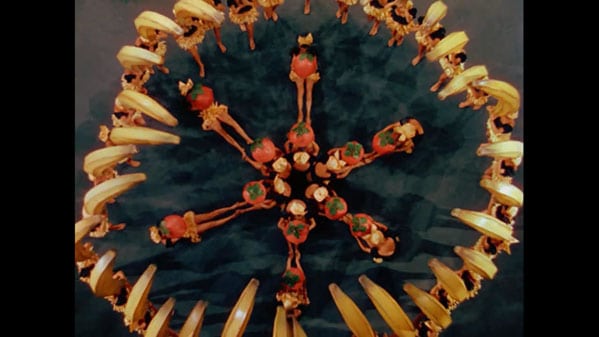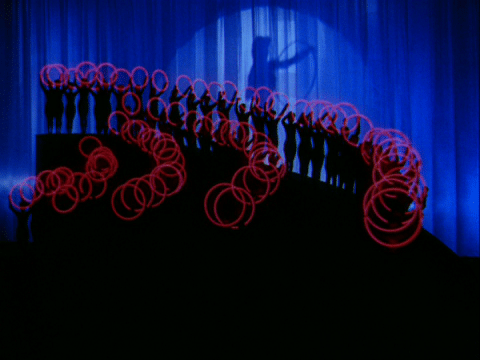The Gang's All Here (1943)
Directed by: Busby Berkeley
Written by: George Root Jr., Nancy Wintner, Tom Bridges, Walter Bullock
Starring: Alice Faye, Benny Goodman, Carmen Miranda, Phil Baker
HCF REWIND NO. 242: THE GANG’S ALL HERE [USA 1943]
ON BLU-RAY: 15th September, from EUREKA ENTERTAINMENT
RUNNING TIME: 103 min
REVIEWED BY: Dr Lenera, Official HCF Critic
Andrew Mason Snr. drags his reluctant neighbour Peyton Potter out to a club and Peyton ends up on the stage dancing with Brazilian sensation Dorita. Andrew’s son Andrew Mason Jnr., on the evening before he leaves to fight in the South Pacific, is in the same place and falls for showgirl Eadie Allen. So she won’t be put off by the fact he has a very rich father, Andrew Jnr. gives himself a different name and eventually leaves her starry-eyed, though he’s actually ‘sort of’ engaged to childhood sweetheart Vivian, who is Peyton’s daughter. When Andrew Snr. hears that his son has won a medal and is returning from the war, he decides to give him a hero’s welcome and talks Peyton into helping him put on a show….
There is a scene roughly around the middle of The Gang’s All Here that reminded me why, despite me writing for a website called Horror Cult Films, sometimes the musical can be one of the most magical and pure types of film. People are hanging around by an outdoor pool, and a young man is trying to persuade a much older lady to dance. She is Mrs. Peyton Potter, and a respectable well-to-do housewife. The young man starts dancing in a very show-offy manner, and the woman seems impressed, but still doesn’t seem to want to dance. However, she has a somewhat shady past as a showgirl, and eventually can’t resist joining him and busting out some moves that put his efforts to shame. It’s a great little scene that made me grin from ear to ear, one of those moments that should make almost anyone feel happy, and yet it almost seems like a throwaway moment in a film which is a simply amazing 103 mins of Olde Hollywood escapism. One of the best things about writing for a website for me is that I get chances to see films I would probably not really have sought out. Thanks to Eureka Entertainment, I’ve now had the chance to see The Gang’s All Here, a lavish, extremely imaginative, and in fact often downright outrageous, musical from 1943, and I almost wish it had been made in 2014, because then I could say it’s one of the best films of the year.
The name Busby Berkeley isn’t one mentioned too often these days, and I’m ashamed to admit that up to viewing The Gang’s All Here I’d never seen a single one of his movies. He is regarded as one of the greatest dance choreographers and directors of the Hollywood musical and after watching The Gang’s All Here I can see why. Gene Kelly once said: “If anybody wants to know what can be done with the camera, tell him to study every shot Busby Berkeley ever made”, and he was at least partly right, judging by the extraordinarily high quality of the film making, not to mention the innovation, on show in The Gang’s All Here. This film was Berkeley’s first colour production, and was shot under the working title The Girls He Left Behind. Linda Darnell was originally intended to star as Vivian Potter, but first sprained her ankle, then ran away with cinematographer Peverell Marley. Fox’s head Darryl Zanuch was busy in Europe, so William LeBaron temporarily took over the studio, but LeBaron and Berkeley failed to get on due to Berkeley’s refusal to agree to LeBaron’s budget-trimmings [which were requested of all businesses during World War 2]. Three songs: Pickin’ on Your Momma, Sleepy Moon and Drums and Dreams were cut before release. Like much of Berkeley’s work, The Gang’s All Here when initially released, though his work fell out of favour until it was rediscovered in the 60’s, hardly a surprising fact considering how ‘out there’ some of his stuff is.
I knew I loved this movie right from the very elaborate and extremely witty opening scene which begins with a disembodied head starting to sing Brazil [the same number featured in the amazing film of that title, and probably the Depression-era escapist song] and, as the song goes through different permutations and even becomes another at times, there’s a great dance number on a New York harbour which seems to mock fads and even wartime shortages of the time. The main performer in this scene is the “Brazilian bombshell” Carmen Miranda. I’d never seen any of her films before either, and I now want to see them all, because she has such as a terrific screen presence, a female force of nature. The set on which all this takes place is obviously a set, but it doesn’t really matter, and it’s really a surprise when the camera pulls back to reveal that everything is actually all happening on a stage. The film is full of clever, self-aware moments like this, my favourite being one just before a romantic duet where the man wonders where the orchestra is coming from and the woman replies: “Use your imagination” as the sound does come on. If you dislike musicals, I reckon that one of the main reasons for that dislike would be that you find it annoying and stupid the way characters can burst into song at the drop of a hat and music can suddenly come on.
Of course this film is almost incredibly kitschy too and you won’t believe they got away with a huge number involving scantily-clad girls carrying huge bananas [though the censors did require that the girls hold the bananas at the waist and not at the hip, and it caused the film to be banned in Miranda’s native country, Brazil]. Watching much of this movie is like watching somebody’s fever dream, and it all climaxes with a sequence with such astounding and inventive visuals that it becomes virtually psychedelic, from the opening of loads of red rings gradually revealed amidst blackness to the kaleidoscopic dance patterns [one of Berkeley’s trademarks, but I’d never seen anything like it] at the end. The filming of all this shows immense mastery, with lots of great tracking shots along the participants [one of them shows lots of doubles of one of the female characters and I’d love to know how they pulled it off because it’s really convincing] and even some long takes with ‘hidden’ cuts five years before Alfred Hitchcock’s Rope. Perhaps the actual music doesn’t quite match some of the visuals, but the songs are all pleasant to hear. Numbers like Padukah and The Lady in the Tutti Frutti Hat are good examples of the kind of nonsensical but also quite clever wordplay you don’t get in songs now and with the great Benny Goodman in charge of the orchestra as well as performing, you know the musicianship is second to none.
The plot….ah, I almost forgot. Well it’s partly the “let’s put on a show” premise which was old even in 1943 and has been used as recently as in The Muppets, and partly screwball comedy-type complications. It’s a little hard to care too much about our hero Andy Jnr. as he romances a showgirl while not seeming to care he has a fiancée, and the film’s position on this kind of thing and indeed its general message [in addition to: “buy lots of war bonds”] can be surmised from the line: “give your cheatin’ soldiers a break – they’re fightin’ a war over there for you”, while it’s all resolved in a ‘too easy’ fashion. Nonetheless Walter Bullock’s screenplay has much wit and sparkle in the dialogue and some genuinely funny moments like when Mrs. Peyton thinks she’s picking up her phone to answer it and is actually lifting up, and talking to, her cat. The three central performers do fine [with Alice Faye probably being the best singer in the whole film and excellently ‘acting out’ one song, the poignant ballad No Love, No Nothin‘ where she’s basically singing about her own situation on stage], but it’s many of the others who almost steal the show, like the luminous Miranda and some great other supporting characters, one of them played by Edmund Everett Horton, a largely unsung Golden Age actor who seems to have been in most of the great comedies of the 1930’s and whom I’ve loved since seeing his wonderful turn in Lost Horizon. The guy’s mannerisms and delivery of lines which in many other performer’s hands may be quite ordinary always make me laugh.
I was one person who came late to the Blu-ray party, being perfectly content with DVD up to a couple of months ago, and even then felt that Blu-ray was only really good for modern movies. How good can a film from the 1940’s ever really look? Well, The Gang’s All Here just looks fabulous on Blu-ray, the vibrant colours almost leaping off the screen, and I can’t imagine it looked as good even on 1943 cinema screens. Maybe in the end it’s all just fluff, and actually if you think about it there are a few highly ridiculous and unbelievable moments, but this isn’t meant to be a realistic film anyway. I loved The Gang’s All Here. Its superb Blu-day presentation is just another reason why I wholeheartedly recommend this hugely artistic, audacious yet supremely entertaining example of the type of film they just don’t make anymore. It’s insanely fun, yet borders on the surreal in such a way that you can really sense its makers trying to push the boundaries of film and what was possible at the time. As I finish this review, I have come to think that the musical, because of the very nature of its format, actually offers a greater oppurtunity for creativity and experimentation in ‘commercial’ cinema than many other genres.
Rating: 









SPECIAL FEATURES:
• New high-definition 1080p presentation
• English subtitles for the deaf and hearing-impaired
• New & exclusive full-length audio commentary with critics Glenn Kenny and Farran Smith Nehme and film historian Ed Hulse
• The documentary Busby Berkeley: A Journey with a Star
• A deleted scene from the film
• Trailer
• A 36-PAGE BOOKLET featuring essays on the film by critics David Cairns and Karina Longworth, and more!






Be the first to comment